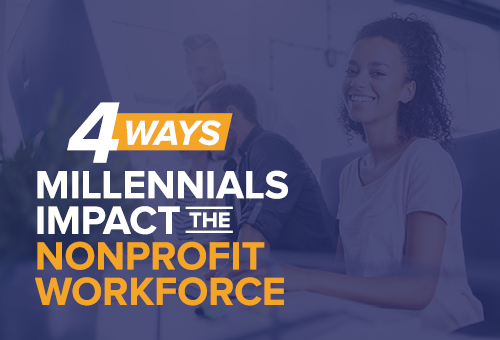Now that they are all of-age, Millennials have joined the workforce (and volunteer force) with full steam ahead. The introduction of this generation to the workforce came as a jolt to many, as the values and motivations of this generation were unprecedented. Now, just as we’ve finally wrapped our minds around the nature of Millennials, another generation is cropping up behind them – Gen Z – and what a fascinating generation it is!
Reviewing the two, it helps to start with simple comparisons. Comparing Millennials to Gen Z, there are many similarities with subtle differences. For example…
- Millennials are tech-savy, introduced to technology at a young age with home computers, laptops, cell phones, etc. In contrast, Gen Z are tech natives, born and raised with cell phones, iPads, smart watches, etc.
- Millennials are motivated to engage in justice work (social, environmental, etc.) due to the dissonance between what they were raised to believe vs what they eventually learned over time due to self-educating resources. Gen Z are being born and raised with discussions of justice, and therefore have an intuition and familiarity with such topics. While millennials often drift into justice work, Gen Z root themselves in it.

There are also a handful of areas that are rather uniform in both generations:
- Both generations are value and mission driven in their actions, beliefs, career choices, purchases, and philanthropic behaviors (including volunteering and donating).
- Both generations are laser-focused on the positive and negative impacts of the companies and organizations they support or are affiliated with. They are no stranger to thorough research or accountability.
- Finally, both generations appreciate the art, innovation, and creativity that comes with problem-solving — hence the warm embrace of “viral” culture in both generations.
How Millennials Pushed the Needle
Millennials began pushing the needle with their notably increased interest in careers in the nonprofit sector. Rather than climbing corporate ladders, Millennials want to do work that matters. This motivation, in combination with the 2000’s cultural surge in entrepreneurship, cultivated a brand new industry intersection that is quintessentially Millennial: social entrepreneurship.
If you think about it, social entrepreneurship leverages Millennial strengths perfectly: mission-driven work, technology-based solutions, creative branding, and digital social marketing.
Millennials are the generation that brought corporate social responsibility to the table — to the executive table, to be exact. Before, it was much more rare to observe corporate responsibility in action. Many corporations shared a common goal — to make more revenue. Until recently, corporate social responsibility made little impact on revenue.
However, Millennials leveraged their widespread digital presence and collective purchasing power to force corporations to care. There seemed to be a gradual realization: in order to appeal to the growing generation of Millennial workers and consumers, businesses needed to prove their values and measure impact.
This insight became important for industries of all kinds, including the nonprofit industry. Although the nonprofit industry was already values-driven and mission-driven, Millennials applied more pressure to nonprofit accountability. The idea being, “Your heart might be in the right place, but what are the true impacts and consequences to which you must remain accountable?” (For example, the issues surrounding voluntourism and White savior complexes.)
This question of accountability has bled into the decision-making process of Gen Z as well, which we will discuss next.
How Gen Z Is Pushing the Needle
Millennials started widespread conversations about justice, responsibility, and accountability in a way that forced corporations and nonprofit organizations to care and respond. In a way, Millennials built the foundation for the work that Gen Z would carry on (and is carrying on).
Let’s take the generationally shared question: “Your heart might be in the right place, but what are the true impacts and consequences to which you must remain accountable?”
As said in the Philanthropy Journal at NC State University, “The task of the nonprofit is to prove beyond reasonable doubt that they are who they profess to be, and that their impact is tangible.”
Gen Z does not only ask the tough questions — they find the answers, make decisions, and apply pressure accordingly. Meaning, for example, that they will not only decline a job offer from a corporation that is not aligned with their values; Gen Z will take it a step further to communicate the misalignment to those they are responding to, encouraging — at times urging — others to do the same.
After all, one of the major ways Gen Z has moved the needle is through the immeasurable surge and value of social influence.
Although it is more difficult for companies and organizations to truly earn this generation’s trust, the value of this trust is worth the effort of earning it. Gen Z relies on the trusted feedback of those they choose to follow on social platforms — whether those people are friends and family, internet friends, or celebrities and influencers.
Therefore, it becomes in the best interest of corporations and organizations to appeal to the interests of those influencers, as word will spread quickly, cost-effectively, and exponentially. If customer or constituent trust and feedback was important before, it’s even more important now.
Gen Z works as a collective, in many ways, rather than as an individual (as is more commonly observed in Millennials). Gen Z is more diverse than any of the generations before, and interestingly, that diversity inspires a much deeper generational understanding and commitment to advocacy for themselves and their peers. Although most of Gen Z is currently underage, it is safe to predict that the collective purchasing power of Gen Z will be far greater than even Millennial purchasing power. The thorough, thoughtful decision of one will much more effectively influence the decisions of their peers.
The majority of Gen Z is still quite young, so we have to watch our predictions over time. Here are a few predictions that are a safe bet:
- As tech natives, Gen Z will request and require more technology solutions at worksites, volunteer sites, homes, and communities.
- Eventually, the world will care about what this generation cares about — whether due to genuine interest and influence, or commercial/economic pressure.
- Just as values-based and responsibility-focused careers were created or expanded for Millennials joining the workforce, new and prominent roles will likely be created for Gen Z as well. Workplaces will be restructured to include more roles relating to workplace justice and community impact, as well as roles that enforce systematic checks and balances, ensuring measured impact is followed closely by actionable accountability.
Stay tuned as the youngest generation grows up and joins the workforce. They are likely to bring great change to the world we live in, just as generations before have done in their own unique way.





 Step three – be gracious
Step three – be gracious Retired:
Retired:  Parents:
Parents: Singles & Newlyweds:
Singles & Newlyweds: Teenagers:
Teenagers:
 Keep it Social. Social media is a top way for Millennials to communicate with their peers (and then some), so offering a well-rounded social media presence to your volunteers is key. A strong Instagram account, designated hashtags for your event and live updates with platforms like Facebook Live and Snapchat offer volunteers an opportunity to share their volunteering experience with their social circles. Bonus: they can help spread the word about your organization to friends and followers!
Keep it Social. Social media is a top way for Millennials to communicate with their peers (and then some), so offering a well-rounded social media presence to your volunteers is key. A strong Instagram account, designated hashtags for your event and live updates with platforms like Facebook Live and Snapchat offer volunteers an opportunity to share their volunteering experience with their social circles. Bonus: they can help spread the word about your organization to friends and followers! Swag. Everyone loves swag, but Millennials are especially excited about the offer of free anything. Shirts, caps and tote bags are classics, but you can also get creative with branded koozies, visors, fannypacks and more. And, when in doubt, offer snacks! Something as simple as a few bags of chips and some seltzer water goes a long way.
Swag. Everyone loves swag, but Millennials are especially excited about the offer of free anything. Shirts, caps and tote bags are classics, but you can also get creative with branded koozies, visors, fannypacks and more. And, when in doubt, offer snacks! Something as simple as a few bags of chips and some seltzer water goes a long way. Be Transparent. At the end of the day, volunteers are there because they care about your organization. Have a well thought out mission statement and ample information on how your organization helps your community. Offering a clear, concise explanation of what your organization does gives volunteers a quick way to explain why they’re volunteering for your specific event.
Be Transparent. At the end of the day, volunteers are there because they care about your organization. Have a well thought out mission statement and ample information on how your organization helps your community. Offering a clear, concise explanation of what your organization does gives volunteers a quick way to explain why they’re volunteering for your specific event.